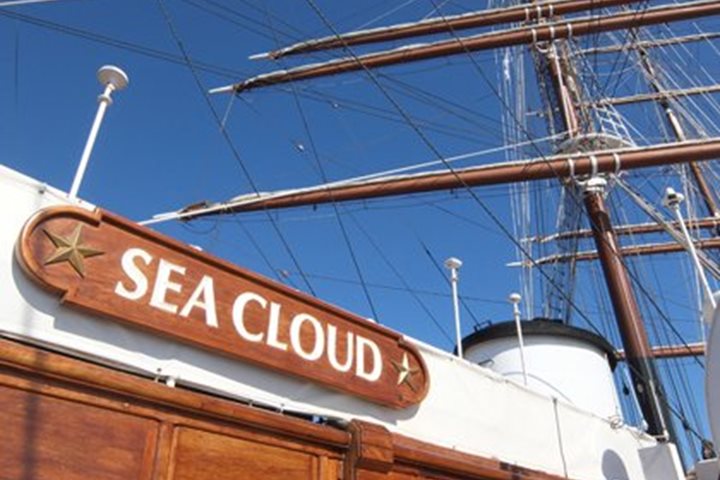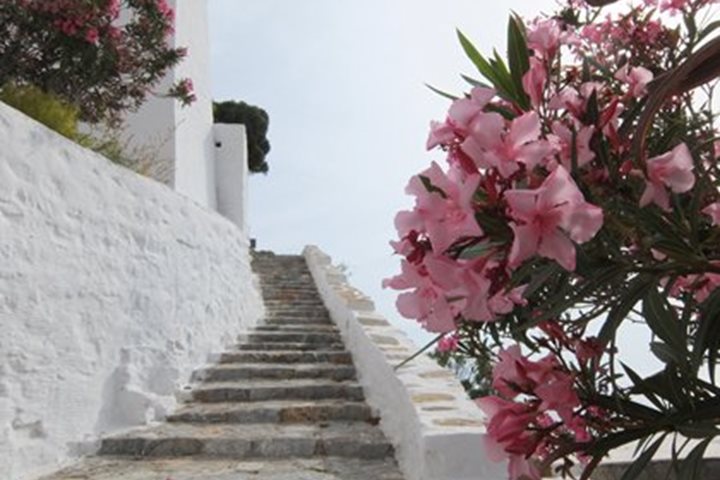The decks of the ship seemed strangely quiet when Captain Pushkarev sent the deck crew to sail stations at 0800 to set the sails. We had a moderate northwesterly breeze blowing with the Cycladic Island of Amorgos catching the morning light to our north, but most of us were not yet up and about on this full day at sea. And who could blame us? We’d had a full few days in Turkey with early morning departures to beat the crowds and the heat, and today was devoted to relaxing in our favorite spots on the ship and sorting out our photos from the past few days. We were expecting the breeze to freshen through the day, so we only set the topmast staysails and the square sails to the topgallants, since the royals and sky sail would heel the ship over in a strengthening wind.
Slowly our shipmates appeared as the breakfast buffet became a comfortable morning “symposium.” We had taken on our Greek cultural specialists Effie and Stella the evening before in the Dodecanese Island of Kos, and this morning they teamed up for an overview of the Aegean Sea and the Cycladic Islands. Effie introduced us to some of the mythological foundations of the Aegean Sea, named when King Aegeus flung himself off the cliffs at Cape Sounion when his son Theseus forgot to change his sails from black to white after slaying the Minoan Minotaur. We heard about the birth of the twin gods Apollo and Artemis on the floating island of Delos, which became the center of the ancient Greek world with the Cycladic Islands forming a circle—or kykla—around it. And then Stella gave us a brilliant overview of the history of civilizations that were based in the Aegean, starting with the Archaic peoples 5,000 years ago who controlled the trade of the sharpest natural edge of the era—obsidian—and developed a sailing and trade culture that also left behind an unbelievably abstract and evocative art form now known as Cycladic Art. From there the earth goddesses of the Minoans and their Mediterranean trade, yielding to the Hellenic warrior tribes from the north who developed into the classical Greek civilizations that we know so well today. The Romans, the Byzantines, the Venetians, the Ottomans, and the modern day Greeks all using these rough and inhospitable islands as stepping stones of trade through a few millennia. Thank the gods for the olive and the grape, which are easily hybridized and flourish on poor and arid soils.
But where was the wind? We had hit a dead spot and the sailing was slow, so Captain Pushkarev set the royals and the inner and outer jibs in hopes of catching a little more wind. Just as he did, the wind picked up again and carried us southward in an 8-knot hurry between the islands of Anafi and Santorini. It was an excellent sail, and we had to take in the jibs and staysails so as not to sail too far south since a square-rigger has no brakes.
Finally we clewed up the square sails in the late afternoon and settled into the lido bar for a talk on the history of the Sea Cloud. We all knew that she was a legendary ship, but few of us had any idea about the many dramas and incarnations that this elegant lady had endured through her 82-year history. We finished with a champagne reception in the original 10 staterooms, followed by a delectable dinner in the Sea Cloud’s original dining room and lounge, wrapping up a near-perfect day at sea.









